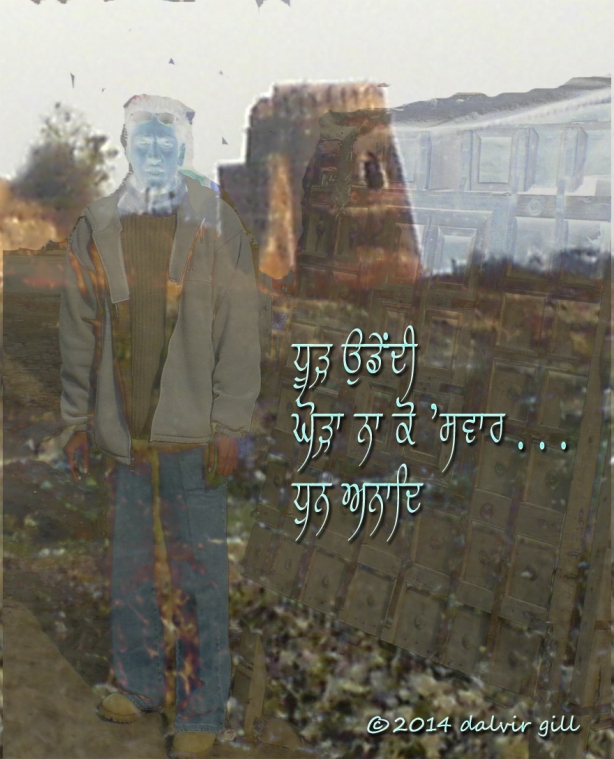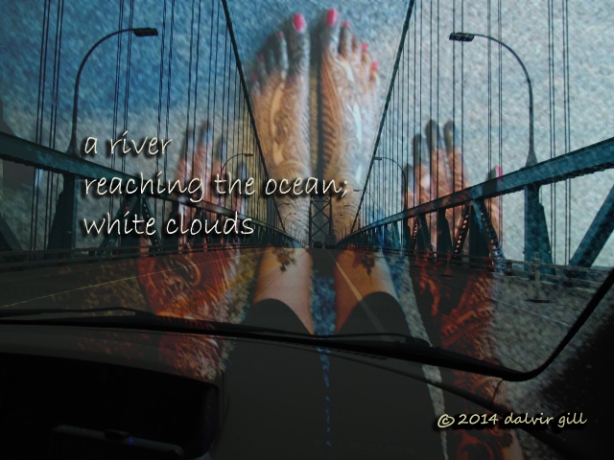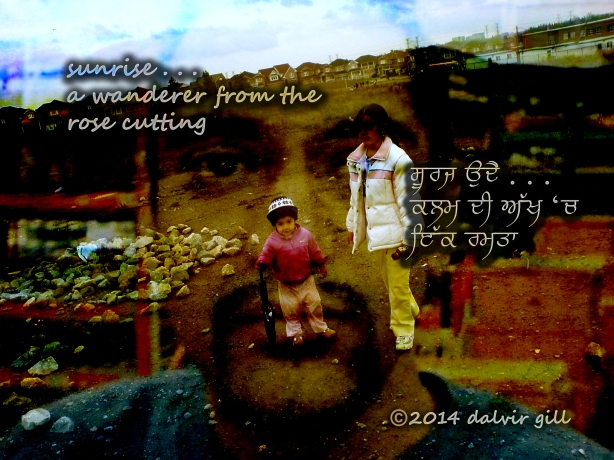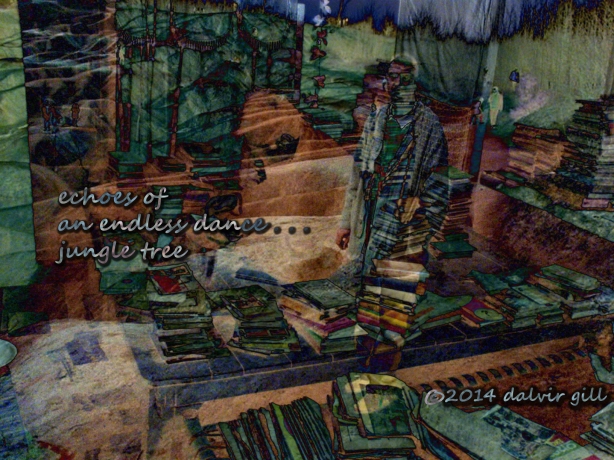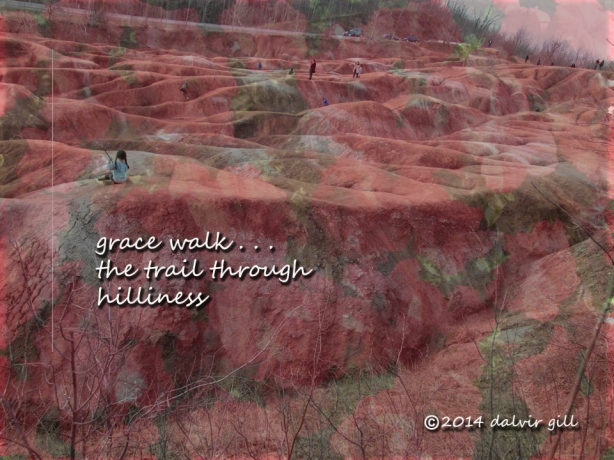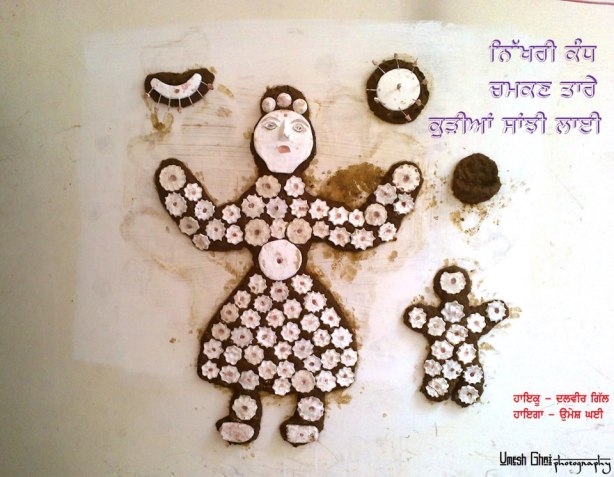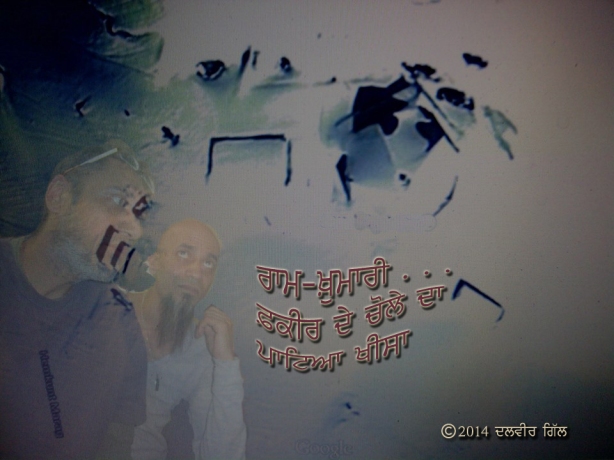ਧੂੜ ਉਡੇਂਦੀ
ਘੋੜਾ, ਨਾ ਕੋ ਸਵਾਰ . . .
ਧੁਨ ਅਨਾਦਿ
Archive for the ‘Dalvir Gill’ Category
Soundless Bang
Posted: October 1, 2014 in Dalvir Gill, Dalvir Gill, Dalvir Gill, Haiga, Haiku, Haiku Punjabi, Hokku, Photography, WriterTags: Dalvir Gill Haiga, Dalvir Gill Haiku, Haiga, haiku, Haiku Punjabi, Hokku, Ma, Nature, Photography, Poetry Dalvir Gill, Soundless Bang, Yugen, ZÔKA
A Lullaby
Posted: September 30, 2014 in Dalvir Gill, Dalvir Gill, Dalvir Gill, Haiga, Haiku, Hokku, Photography, WriterTags: Dalvir Gill, Dalvir Gill Haiga, Dalvir Gill Haiku, Haiga, haiku, Haiku Punjabi, Hokku, Lullaby, Ma, Photography, Poetry Dalvir Gill, Yugen, ZÔKA
Merging
Posted: September 29, 2014 in Dalvir Gill, Dalvir Gill, Dalvir Gill, Haiga, Hokku, Photography, WriterTags: Dalvir Gill Haiga, Dalvir Gill Haiku, Haiga, haiku, Hokku, Ma, Merging, Nature, Photography, Poetry Dalvir Gill, Yugen, ZÔKA
A Wanderer
Posted: September 28, 2014 in Dalvir Gill, Dalvir Gill, Dalvir Gill, Haiga, Haiku Punjabi, Hokku, Photography, WriterTags: A Wanderer, Dalvir Gill, Dalvir Gill Haiga, Dalvir Gill Haiku, Haiga, haiku, Haiku Punjabi, Hokku, Ma, Nature, Photography, Poetry Dalvir Gill, ZÔKA
Jungle Tree
Posted: September 28, 2014 in Dalvir Gill, Dalvir Gill, Dalvir Gill, Haiga, Hokku, Photography, WriterTags: Dalvir Gill, Dalvir Gill Haiga, Dalvir Gill Haiku, Haiga, haiku, Hokku, Jungle Tree, Ma, Photography, Poetry Dalvir Gill, Yugen, ZÔKA
Grace-Walk
Posted: September 25, 2014 in Dalvir Gill, Dalvir Gill, Dalvir Gill, Haiga, Haiku, Hokku, Photography, WriterFrom Hototogisu To Kokil, With Love—DalvirGill
Posted: September 17, 2014 in Dalvir Gill, Review, WriterTags: ਕੋਕਿਲ ਅੰਬਿ ਸੁਹਾਵੀ ਬੋਲੇ, ਪੁਸਤਕ ਰੀਵਿਊ, ਸੰਦੀਪ ਚੌਹਾਨ, ਸੰਦੀਪ ਸੀਤਲ ਚੌਹਾਨ. ਹਰਵਿੰਦਰ ਧਾਲੀਵਾਲ ਬਿਲਾਸਪੁਰ, ਹਰਵਿੰਦਰ ਧਾਲੀਵਾਲ ਬਿਲਾਸਪੁਰ, ਹਾਇਕੂ ਪੁਸਤਕ, Criticism, Dalvir Gill, haiku, Haiku Punjabi, Kigo, Ma, Mono No Aware, Nature, punjabi haiku, Review, Sabi, Sandip Chauhan, Wabi, Yugen
From Hototogisu To Kokil, With Love—DalvirGill
Kokil Amb(i) Suhavi Bole (The Sweet Song of Koel Bird From the Mango Tree) is mainly a book on haiku, with an added bonus of 363 haiku/senryu by 18 haiku-poets including those by editor Sandip Chauhan and Harvinder Dhaliwal, Co-Editor. This is the second haiku anthology edited by Dr. Chauhan. (Previously she co-edited In One Breath –– a Haiku moment with Elaine Andre in which Andre wrote a pithy, condensed and concentrated introductory essay on the genre.)
The book is divided into two major parts: A collection of haiku/senryu and an essay by Dr. Chauhan. The 43-page essay is further divided into three major parts, along with a small note on senryu and the very important Concluding Remarks.
- Haiku: The Form and Function –– deals with the form of the genre, it’s history; the haiku vision, haiku mind-set, haiku moment; its relation to and the importance of kigo, the place and position of kigo in haiku that is written outside of Japan.
-
Haiku: It’s Structure & Creative Tools –– deals with the form or structural elements of haiku, namely kireji (cutting word); its what, how and why, and paying special attention to Ma (gap, pause, or negative space), explaining that it is not only the structural value of cutting a poem into much expounded-on ‘phrase and fragment’ but how these two parts juxtaposed have psychological and philosophical affects on the reader and invite one to enter into the poem, participate, and complete it for oneself. All this is discussed in the same manner as was done with the kigo, that is, that kigo is important not only to the form but also adds a certain emotional value to the poem in enabling a reader to relate to it by entering into it through this door and to re-create it by interpreting, traveling across time and space.
In this sub-chapter while discussing the Language of Haiku, metaphor (overt, unresolved, absolute), simile, and allegory are discussed. It is suggested that these shouldn’t be used in the same sense as in the other genres of poetry/literature, for they appear, when they do, in a haiku with a widely different value and in a nature that’s unique to haiku. And, even though haiku may have a certain internal rhythm, but end-rhyme or a conscious effort to create rhyme, while dulling the elements of haiku, can almost eliminate the effect created by kire (cut marker) and turn it into a three-line free-verse.
- Haiku: Aesthetic Principles –– deals with often ignored and omitted, less discussed aspects of Japanese aesthetics in reference to haiku, vis-à-vis yugen, wabi, sabi, and mono no aware. Here too, these elements/principles are discussed as to why they are important, and how these are used in haiku.
The Concluding Remarks portion is very important. Using the analogy of “A River and Its Banks” to ‘creative process and creation/technical rules’, offered by a prominent Indian scholar Kala Ramesh (an aesthete who is an expert on Indian classical dance & music and haiku), Dr. Chauhan not only talks about the importance of the one to the other but suggests that because the kigo is always local, Punjabi haiku lovers and all other communities of haiku writers in their respective native languages and/or in their particular geographical spheres shall work towards creating their own Saijiki. It does make sense. For example, we associate frog with monsoon but in classical Japanese saijiki frog is a kigo for spring. And most importantly, we have six seasons while the Japanese have four.
It should be pointed out that this is the third book in Punjabi that’s not merely a collection of haiku by one or more poets, but deals with the genre at length. The first book was Japanese Haiku Shyeri (Japanese Poetry: Haiku) by Parminder Sodhi, who was a Punjabi poet residing in Japan for over two decades, to whom this book is dedicated. Until its publication, no one in Punjabi literary circles had really heard of haiku, so the book was more an introduction to the genre. Then a reader of that book, Mr. Amarjit Sathi, after forming the Punjabi Haiku Forum and Haiku Group on Facebook, c. 2008, watching the growing popularity of haiku among Punjabi poets and upon a unanimous demand from them, put together the second book Haiku Bodh (The Haiku Primer), in which he borrows heavily from the Haiku Society of America and Western scholars, and for the most part, translates their views/definitions for those Punjabi poets who weren’t that well-versed or fluent in the English language. Mr. Sodhi’s book was leaning more toward classical form when Punjabi poets were almost oblivious to the genre. Mr. Sathi’s book came when a number of Punjabi poets were creating haiku/senryu, and he does make use of those poems to exemplify different aspects of the genre, but does so within the periphery defined by English language scholars, and consequently, doesn’t show any attempt to start a dialogue with the original Japanese form from the Punjabi perspective.
Dr. Chauhan’s book, being the third book on the chronological chart, can be rightly called The First Book on Haiku in Punjabi. Even in the Preface by Dr. Jaswinder Singh –Dean, Academic Affairs and Professor, Punjabi Department, Punjabi University, Patiala, India, Dr. Singh points out the matters which are central to and burning among Punjabi haiku enthusiasts and currently are not central to the international haiku scene.
Other than the dozen or so collections of Punjabi haiku that have been published, and even though this is the third chronological book on haiku in Punjabi, this is the first comprehensive volume. It not only suggests bypassing the English Language Haiku (ELH) experience, it wants us to connect directly to Japanese masters & Japanese aesthetics and fairly does so itself. Dr. Chauhan has her finger on the pulse through her colleagues; Dr. Gabi Greve, a professional translator who has a direct experience of Japan and haiku, and Elaine Andre, who shared research and made this haiku journey with her. The abundant footnotes indicate that while trying to understand the major concepts of Japanese aesthetics, Dr. Chauhan didn’t restrict her research to English language scholars but approached them through different channels – painting, architecture, Noh theatre. And there’s a conscious effort to avoid all the Western misconceptions about haiku. This kind of research is quite scarce in the English world and utterly non-existent in Punjabi or in the other Indian languages.
The Cooing Dove
Posted: September 1, 2014 in Dalvir Gill, Hokku, WriterTags: Dalvir Gill, Dalvir Gill Haiku, haiku, Hokku, Ma, Nature, Poetry Dalvir Gill, Yugen
cooing dove
below the rainbow . . .
fall leaves
https://www.facebook.com/groups/183106485170841/permalink/380083042139850/
ਹਰ ਸਹਰ, ਇੱਕ ਨਵਾਂ ਸਫ਼ਰ – ਘਰ ਏਹਾ
Posted: August 29, 2014 in ਬਾਸ਼ੋ ਦਾ ਹਾਇਬੁਨ, Basho, Dalvir Gill, Haibun, Translations, WriterTags: ਬਾਸ਼ੋ ਦਾ ਹਾਇਬੁਨ ( ਅਨੁਵਾਦ )
ਬਾਸ਼ੋ ਦਾ ਹਾਇਬੁਨ (ਇੱਕ )
( ਡਾਨਲਡ ਕੀਨ ਦੇ ਜਾਪਾਨੀ ਤੋਂ ਅੰਗ੍ਰੇਜ਼ੀ ਵਿੱਚ ਕੀਤੇ ਅਨੁਵਾਦ ‘ਤੇ ਆਧਾਰਿਤ )
( ਅਨੁ. ਦਲਵੀਰ ਗਿੱਲ )
***************************************************************************************************************************
ਮਾਹ-ਦਿਨ, ਅਨੰਤ ਕਾਲ ਤੋਂ ਯਾਤਰੂ ਹਨ। ਆਉਂਦੇ ਜਾਂਦੇ ਸਾਲ ਵੀ ਮੁਸਾਫ਼ਿਰਾਂ ਵਾਂਗ ਹੀ ਹਨ। ਸਮੁੰਦਰੀ ਜਹਾਜਾਂ ਦੇ ਸਵਾਰ ਜੋ ਸਦਾ ਸਫ਼ਰ ‘ਤੇ ਰਹੇ ਜਾਂ ਉਹ ਜਵਾਨ ਜੋ ਘੋੜਿਆਂ ਦੀਆਂ ਲਗਾਵਾਂ ਸਾਂਭੀ, ਚਲ-ਸੋ-ਚਲ ਕਰਦੇ, ਕਾਠੀਆਂ ਰਕਾਬਾਂ ਵਿੱਚ ਹੀ ਬੁਢੇ ਹੋ ਗਏ; ਸਫ਼ਰ ਦੇ ਜਿਸ ਮੁਕਾਮ ‘ਤੇ ਰਾਤ ਪਈ ਉਹੋ ਉਹਨਾਂ ਦਾ ਘਰ ਹੋ ਨਿਬੜਿਆ। ਪੁਰਾਣੇ ਵਕ਼ਤਾਂ ਵਿੱਚ ਨਾ ਜਾਣੇ ਕਿੰਨਿਆਂ ਨੂੰ ਮੌਤ ਨੇ ਉਦੋਂ ਆਪਣੀ ਗੋਦ ਵਿੱਚ ਲਿਆ ਜਦੋਂ ਉਹ ਅਜਿਹੀਆਂ ਸਫ਼ਰੀ ਮੁਹਿੰਮਾਂ ਵਿਚਕਾਰ ਹੀ ਸਨ; ਪਿਛਲੇ ਕੁਝ ਸਾਲਾਂ ਤੋਂ ਹਵਾ ਦੇ ਧੱਕੇ ਚੜ੍ਹਿਆ ਕੋਈ ਬੱਦਲ ਵੇਖ ਕੇ ਮੇਰੇ ਅੰਦਰ ਵੀ ਵਿਚਾਰਾਂ ਦੀ ਇੱਕ ਅਟੁੱਟ ਲੜ੍ਹੀ ਚਲ ਪੈਂਦੀ ਹੈ – ਰਮਤਾ ਹੋ ਜਾਣ ਦੀ।
ਪਿਛਲਾ ਸਾਰਾ ਸਾਲ ਮੈਂ ਸਾਗਰ ਦੇ ਤੱਟ ਲਾਗੇ ਇਵੇਂ ਘੁਮੱਕੜ-ਪੁਣੇ ਵਿੱਚ ਹੀ ਗੁਜ਼ਰ ਦਿੱਤਾ। ਪੱਤਝੜ੍ਹ ਦੇ ਆਉਣ ਤੱਕ ਮੈਂ ਆਪਣੀ ਨਦੀ ਕਿਨਾਰੇ ਵਾਲੀ ਕੁਟੀਆ ਵਿੱਚ ਪੁੱਜ ਗਿਆ ਅਤੇ ਉਸ ਵਿੱਚ ਲੱਗੇ ਹੋਏ ਮੱਕੜੀਆਂ ਦੇ ਜਾਲ਼ਿਆਂ ਨੂੰ ਝਾੜਿਆ ਪੂੰਝਿਆ। ਹੁੰਦੇ ਹੁੰਦੇ ਸਾਲ ਮੁੱਕਿਆ। ਬਸੰਤ ਰੁੱਤ ਦੀ ਆਮਦ ‘ਤੇ ਜਦੋਂ ਅਜੇ ਵੀ ਧੁੰਦ ਹੁੰਦੀ ਸੀ ਮੈਂਨੂੰ ਫੁਰਦਾ ਕਿ ਸ਼ੀਰਾਕਾਵਾ ਵਾਲਾ ਨਾਕਾ ਟੱਪ ਕੇ ਓਕੂ ਦੇ ਇਲਾਕ਼ੇ ਵਿੱਚ ਪਹੁੰਚ ਜਾਵਾਂ। ਆਵਾਰਗੀ ਦਾ ਭੂਤ ਮੇਰੇ ਸਿਰ ‘ਤੇ ਸਵਾਰ ਸੀ ਤੇ ਉਸਨੇ ਮੇਰੀ ਮੱਤ ਜਿਵੇਂ ਅਸਲੋਂ ਹੀ ਮਾਰ ਦਿੱਤੀ ਹੋਈ ਸੀ। ਸਫ਼ਰ ਦਾ ਨਿਗਾਹਵਾਨ ਦੇਵਤਾ ਜਿਵੇਂ ਮੈਨੂੰ ਆਵਾਜ਼ਾਂ ਪਿਆ ਮਾਰਦਾ ਸੀ ਤੇ ਮੈਥੋਂ ਕੋਈ ਵੀ ਕੰਮ ਕਰਿਆਂ ਨਹੀਂ ਸੀ ਬਣਦਾ।
ਮੈਂ ਆਪਣੀ ਪਾਟੀ ਪਤਲੂਣ ਗੰਢ ਲਈ ਅਤੇ ਬਾਂਸ ਦੀਆਂ ਛਿਟੀਆਂ ਵਾਲੀ ਆਪਣੀ ਟੋਪੀ ਦੀ ਡੋਰੀ ਵੀ ਬਦਲ ਲਈ। ਲੱਤਾਂ ‘ਚ ਜਾਨ ਪਾਉਣ ਲਈ ਮੈਂ ਪਿੰਡਲੀਆਂ ਅੱਗੇ ( ਨਰਹਰ ‘ਤੇ ) ਜੜ੍ਹੀ-ਬੂਟੀਆਂ[^1] ਦੇ ਲੇਪ ਕੀਤੇ। ਉਦੋਂ ਮੈਨੂੰ ਹੋਰ ਕੁਝ ਨਹੀਂ ਸੀ ਸੁੱਝਦਾ, ਮਾਤ੍ਸੂਸ਼ੀਮਾ ਦੀਪ-ਸਮੂਹ ਤੋਂ ਦਿਸਦੇ ਚੰਦ੍ਰਮਾ ਤੋਂ ਬਿਨਾਂ । ਜਦੋਂ ਮੈਂ ਆਪਣੀ ਕੁਟੀਆ ਵੇਚੀ ਅਤੇ ਸਾਂਪੂ ਦੀ ਨਗਰੀ ਆ ਟਿਕਾਣਾ ਕੀਤਾ, ਜਿੱਥੇ ਮੈਂ ਆਪਣੀ ਯਾਤ੍ਰਾ ਸ਼ੁਰੂ ਕਰਨ ਤੱਕ ਟਿਕਣਾ ਸੀ, ਤਾਂ ਮੈਂ ਇਹ ਕਵਿਤਾ ਥੰਮੀ ਨਾਲ ਲਟਕਾ ਛੱਡੀ:
ਫੂਸ ਦੀ ਕੁੱਲੀ
ਨਵੇਂ ਮਾਲਕ ਹੱਥਿ
ਪਟੋਲ੍ਹੇ ਦਾ ਘਰ! [^2]
ਇਹ ਹੋੱਕੂ-ਲੜ੍ਹੀ ਦੀਆਂ ਅੱਠ ਕਵਿਤਾਵਾਂ ਵਿੱਚੋਂ ਪਹਿਲਾ ਹੋ ਨਿਬੜਿਆ। [^3]
…………………………………………………………………………….
[^1] : In original “Moxa” ( Mugwart )
[^2] : ਪਟੋਲ੍ਹੇ ਦਾ ਘਰ = ਇਸ਼ਾਰਾ ਇੱਕ “ਗੁਡੀਆਂ ਦੇ ਤਿਉਹਾਰ” ਵਲ ਹੈ।
[^3] : ਇਹ ਅਨੁਵਾਦ ਡਾਨਲਡ ਕੀਨ ਦੇ ਜਾਪਾਨੀ ਤੋਂ ਅੰਗ੍ਰੇਜ਼ੀ ਵਿੱਚ ਕੀਤੇ ਅਨੁਵਾਦ ‘ਤੇ ਆਧਾਰਿਤ ਹੈ।
ਮਾਕੋਤੋ ਯੋਏਡਾ ਦੇ ਅਨੁਵਾਦ ਵਿੱਚ ਹੋਰ ਥਾਈਂ ਭਾਸ਼ਾ-ਭੇਦ ਤੋਂ ਇਲਾਵਾ ਅੰਤਲੇ ਹਾਇਕੂ ਨੂੰ ਉਸਨੇ ਇੰਝ ਅਨੁਵਾਦਿਆ ਹੈ:
ਇਸ ਦਰਵਾਜ਼ੇ ਪਿੱਛੇ
ਹੁਣ ਘਾਹ ਹੇਠ ਡੂੰਘਾ ਦੱਬਿਆ
ਭਵਿੱਖ ਦੀ ਕੋਈ ਪੀੜ੍ਹੀ ਮਨਾਵੇਗੀ
ਗੁਡੀਆਂ ਦਾ ਤਿਉਹਾਰ
ਸਾਂਝੀ
Posted: August 27, 2014 in Dalvir Gill, Haiga, Haiku, Haiku Punjabi, Photography, Umesh Ghai, WriterTags: Dalvir Gill, Dalvir Gill Haiku, Haiga, haiku, Haiku Punjabi, Photography, Poetry Dalvir Gill, punjabi haiku, Rites, Rituals, Umesh Ghai
University – ਯੂਨੀਵ੍ਰਸਿਟੀ – विश्वविद्यालय
Posted: August 24, 2014 in Dalvir Gill, Haiku, Haiku Punjabi, WriterTags: Dalvir Gill, Dalvir Gill Haiku, haiku, Haiku Punjabi, Poetry Dalvir Gill, punjabi haiku
ਪੁਲ ਬਣਿਆ
ਜਲ-ਧਾਰ ਤੋਂ ਬਿਨਾਂ . . .
ਯੂਨੀਵ੍ਰਸਿਟੀ
a causeway
without stream or mire . . .
university
पुल है बना
जलधारा न कोए . . .
विश्वविद्यालय
all seasons are beautiful. winter can take an apparently hostile entry but some seasons, like this year’s Fall&Winter, – of the spiral, not that of a circle – feel like Spring.
There is always a part of other Yug present in every Yug …
Even with this constant change, a flux – in nature, our daily life is filled with images which, seemingly, have not changed, at all.
iron-cast imagery . . .
sculpted stone, calenders
on the wall
My Hokku somewhere
Posted: August 24, 2014 in Dalvir Gill, Hokku, WriterTags: Dalvir Gill, Dalvir Gill Haiga, Dalvir Gill Haiku, haiku, Hokku, Mention
Colonial Discourse – ਉਪਨਿਵੇਸ਼ਿਕ ਬਿਰਤਾਂਤ
Posted: August 24, 2014 in Dalvir Gill, Haiku, Haiku Punjabi, WriterTags: Dalvir Gill, Dalvir Gill Haiku, haiku, Haiku Punjabi, Poetry Dalvir Gill
desi butter-milk with
a straw, in English tea-cup . . .
colonial discourse
ਲੱਸੀ ਪਰੋਸੀ
ਵਲਾਇਤੀ ਚਾਹ-ਪਿਆਲੇ ਵਿੱਚ . . .
ਉਪਨਿਵੇਸ਼ਿਕ ਬਿਰਤਾਂਤ
The Skylark
Posted: August 23, 2014 in Dalvir Gill, Haiku, Hokku, WriterTags: Dalvir Gill, Dalvir Gill Haiku, haiku, Hokku, Ma, Nature, Poetry Dalvir Gill, Yugen, ZÔKA
marigold
after the shower . . .
skylark
A Lullaby
Posted: August 23, 2014 in Dalvir Gill, Haiku, Hokku, WriterTags: Dalvir Gill, Dalvir Gill Haiku, haiku, Hokku, Ma, Nature, Poetry Dalvir Gill, Yugen, ZÔKA
a lullaby
floats on the pool . . .
summer lilies
One-Handed-Clap — ਨਾਦਿ ਅਨਾਦਿ
Posted: August 21, 2014 in Dalvir Gill, Haiku Punjabi, WriterTags: Dalvir Gill, Dalvir Gill Haiku, haiku, Haiku Punjabi, Ma, Poetry Dalvir Gill, punjabi haiku, Yugen
ਧੂੜ ਉਡੇਂਦੀ
ਘੋੜਾ, ਨਾ ਕੋ ਸਵਾਰ . . .
ਧੁਨ ਅਨਾਦਿ
White Clouds
Posted: August 19, 2014 in Dalvir Gill, Haiku, Hokku, WriterTags: Dalvir Gill, Dalvir Gill Haiku, haiku, Hokku, Kigo, Ma, Nature, Poetry Dalvir Gill, Yugen, ZÔKA
a river
reaching the ocean;
white clouds
Lullaby – ਲੋਰੀ
Posted: August 15, 2014 in Dalvir Gill, Haiku, Haiku Punjabi, Hokku, WriterTags: Dalvir Gill, Dalvir Gill Haiku, haiku, Haiku Punjabi, Hokku, Ma, Nature, Poetry Dalvir Gill, punjabi haiku, Yugen, ZÔKA
The Extasy … ਰਾਮ-ਖ਼ੁਮਾਰੀ
Posted: August 12, 2014 in Dalvir Gill, Haiku Punjabi, Hokku, WriterTags: Dalvir Gill, Dalvir Gill Haiga, Dalvir Gill Haiku, Haiga, haiku, Haiku Punjabi, Hokku, Ma, Photography, Poetry Dalvir Gill, punjabi haiku, Yugen
